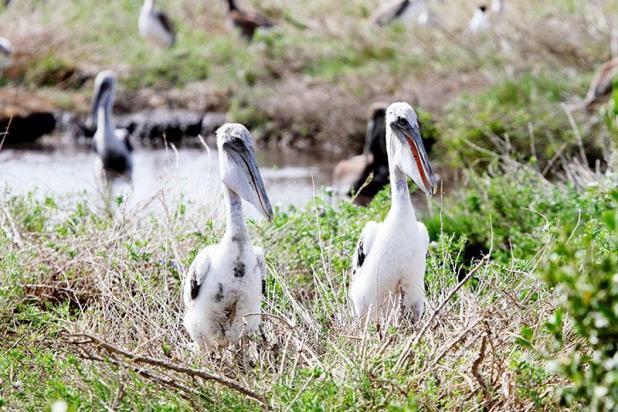
Two brown pelican chicks still in the nest requiring care from their parents. (Submitted Photo/Courtesy of John K. Flores)
LDWF celebrates 50th anniversary of brown pelican restoration
“We are the Pelican State and can you imagine Louisiana without its state bird?,” said Todd Baker, biologist director with the Louisiana Department of Wildlife and Fisheries. “In the 50s and 60s that’s where we were. The last documented nesting brown pelican in Louisiana at that time was 1961. And, by 1963 they were extirpated virtually from the state.”
On July 22, the Louisiana Department of Wildlife and Fisheries celebrated the 50th anniversary of the brown pelican restoration on Queen Bess Island just north of Grand Isle by holding a media day. Attendees heard presentations from biologists and toured the island to see firsthand the results of the dramatic recovery.
Like many species of wildlife, the brown pelican was severely impacted by the use of DDT, an insecticide that wasn’t banned until 1972. The chemical made its way through the Mississippi River drainage system, ultimately reaching Louisiana’s wetlands and marshes. Once DDT got into the fisheries, the chemical bio-accumulated into the pelican population, which led to nest failure.
According to Baker, the brown pelican is absolutely an indicator of the health of Louisiana’s wetlands.
Baker, while addressing the media, said, “Every time something happens in our wetlands, it shows up in this bird. During the BP oil spill we saw it. And we’re also starting to see it with the erosion and wetland loss that we have throughout the state.”
The first release of brown pelicans on Queen Bess Island took place in 1968. And between 1968 and 1975, 705 pelicans were released.
It takes brown pelicans three years to sexually mature. In 1971, the department had its first successful nesting, where 11 nests produced eight chicks that fledged. By 1989, there were 600 nests that fledged approximately 800 young on Queen Bess Island.
What’s uniquely important to consider is, all of the initial activities were done prior to the Endangered Species Act in 1973.
“In 1966, a group of biologists from the LDWF teamed up with some biologists from Florida and hatched out this crazy idea — this pilot project — to go grab chicks from Florida, raise them in Louisiana, hoping we’ll have birds nesting again in Louisiana, Baker said. “DDT was not banned yet in the U.S. until 1972. That’s important, because these guys started before the ban was even in place. So, they were being very proactive in recognizing the importance of having that bird on the landscape.”
It appears peak nesting occurred between 2001 and 2010 on Queen Bess Island, where there were an estimated 4,000 nests in 2008. Once brown pelicans were established again, relocation projects continued through the 80s and beyond. Other islands populated with these birds were North Island, Isle Au Pitre and Last Island. However, brown pelicans can pretty much be seen all along coastal Louisiana today, where the current population is estimated at somewhere between 80,000 to 100,000 birds.
In November 2009, the brown pelican was de-listed and removed from the Endangered Species List. Less than six months later, on April 20, 2010, the worst oil spill in U.S. history occurred where 11 people were killed and 17 people injured during the Deepwater Horizon rig explosion off the coast of Louisiana.
Besides human loss and injury, the spill also had a devastating impact on the environment. Queen Bess Island was heavily oiled during a time when birds were nesting on the island.
Some notable facts concerning Queen Bess are, the island is the third largest rookery for nesting brown pelicans in the state. Annually, 15 to 20 percent of the state’s brown pelican nesting activities occurs there. And, the island is the preferred nesting location for 10 species of birds, some considered of greatest conservation need.
Though Queen Bess is 36 acres in size, just five of its acres is suitable habitat for nesting. Put another way, birds literally nest on top of each other with an estimated 896 nests per acre.
During the celebration, Baker stated that some $200 million had been set aside for bird restoration projects from the $5 billion BP oil spill disaster settlement known as the Natural Resources Damage Assessment.
Queen Bess Island is currently in the design and engineering stage, where the island will undergo restoration with hopes of providing 29 acres of brown pelican and wading bird habitat; 7 acres of nesting tern habitat; and, provide breakwaters on the southwest perimeter of the island as a location where juvenile pelicans can loaf and swim once approved for funding.
The estimated cost of the project is $17.5 million. Officials hope, if funding is approved, the project can begin following the 2019 nesting season, with a targeted goal of completion sometime in early 2020.
Currently, there are three projects in the design and engineering phases. They are Queen Bess Island, Breton Island, located in Plaquemine Parish, which has the largest brown pelican rookery in the state, and Rabbit Island located in Cameron Parish.
John Tirpak, Gulf Restoration Program Science coordinator for the United States Fish and Wildlife Service, spoke during the celebration saying the original restoration and reintroduction of brown pelicans on Queen Bess took three things — imagination, courage and hard work.
As the LDWF, the USF&WS, and their partners embark on restoring Queen Bess Island’s habitat, Tipak says he sees similarities with the efforts it took to reintroduce brown pelicans to the island.
“Today is kind of a celebration of that effort when I think about the brown pelican,” Tirpak said. “I see a symbol of hope, or kind of what is possible when we work together. I see a lot of parallels between the restoration effort and the land loss crisis we face today. It’s going to take a lot of imagination, courage and dedication.”
